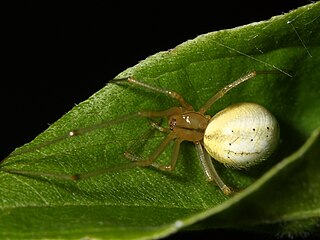
The Thomisidae are a family of spiders, including about 175 genera and over 2,100 species. The common name crab spider is often linked to species in this family, but is also applied loosely to many other families of spiders. Many members of this family are also known as flower spiders or flower crab spiders.

Theridiidae, also known as the tangle-web spiders, cobweb spiders and comb-footed spiders, is a large family of araneomorph spiders first described by Carl Jakob Sundevall in 1833. This diverse, globally distributed family includes over 3,000 species in 124 genera, and is the most common arthropod found in human dwellings throughout the world.

Anyphaenidae is a family of araneomorph spiders, sometimes called anyphaenid sac spiders. They are distinguished from the sac spiders of the family Clubionidae and other spiders by having the abdominal spiracle placed one third to one half of the way anterior to the spinnerets toward the epigastric furrow on the underside of the abdomen. In most spiders the spiracle is just anterior to the spinnerets. Like clubionids, anyphaenids have eight eyes arranged in two rows, conical anterior spinnerets and are wandering predators that build silken retreats, or sacs, usually on plant terminals, between leaves, under bark or under rocks. There are more than 500 species in over 50 genera worldwide.

Orb-weaver spiders or araneids are members of the spider family Araneidae. They are the most common group of builders of spiral wheel-shaped webs often found in gardens, fields and forest. "Orb" can in English mean "circular", hence the English name of the group. Araneids have eight similar eyes, hairy or spiny legs, and no stridulating organs.

Corinnidae is a family of araneomorph spiders, sometimes called corinnid sac spiders. The family, like other "clubionoid" families, has a confusing taxonomic history. Once it was a part of the large catch-all taxon Clubionidae, now very much smaller. The original members of the family are apparently similar only in that they have eight eyes arranged in two rows, conical anterior spinnerets that touch and are generally wandering predators that build silken retreats, or sacs, usually on plant terminals, between leaves, under bark or under rocks.

The ray spiders (Theridiosomatidae) are a family of spiders first described by Eugène Simon in 1881. They are most recognizable for their construction of cone-shaped webs.
Mago is a genus of Ecuadorian jumping spiders that was first described by Octavius Pickard-Cambridge in 1882. As of July 2019 it contains only two species, found only in Ecuador: M. brimodes and M. intentus.

Huttonia is a monotypic genus of ecribellate South Pacific araneomorph spiders in the Huttoniidae family containing the single species, Huttonia palpimanoides. Although only one species is described, there are still about twenty more undescribed species.

Tetrablemmidae, sometimes called armored spiders, is a family of tropical araneomorph spiders first described by Octavius Pickard-Cambridge in 1873. It contains 126 described species in 29 genera from southeast Asia, with a few that occur in Africa and Central and South America. Pacullidae was incorporated into this family in 1981, but was later restored as a separate family in a 2016 phylogenetic study.

Thwaitesia is a genus of comb-footed spiders that was first described by Octavius Pickard-Cambridge in 1881.
Stenochilus is a genus of Asian araneomorph spiders in the Stenochilidae family, and was first described by Octavius Pickard-Cambridge in 1871. As of September 2019 it contains three species, found in Asia: S. crocatus, S. hobsoni, and S. scutulatus. It is considered a senior synonym of Metronax
Idiophthalma is a genus of South American brushed trapdoor spiders first described by O. Pickard-Cambridge in 1877.
Xeropigo is a genus of South American and Caribbean corinnid sac spiders first described by O. Pickard-Cambridge in 1882.
Anisaspoides is a monotypic genus of Brazilian baldlegged spiders containing the single species, Anisaspoides gigantea. It was first described by Frederick Octavius Pickard-Cambridge in 1896, and is only found in Brazil.

Nilus is a genus of nursery web spiders that was first described by Octavius Pickard-Cambridge in 1876.
Mecynargus is a genus of dwarf spiders that was first described by C. Chyzer & Władysław Kulczyński in 1894.

Coleosoma is a genus of comb-footed spiders that was first described by Octavius Pickard-Cambridge in 1882.
Chthonos is a genus of South American ray spiders that was created by Jonathan A. Coddington in 1986 because the previous name was preoccupied. Originally placed with the Orb-weaver_spiders under the name Tecmessa, it was transferred to the ray spiders in 1986.

Ogulnius is a genus of ray spiders that was first described by Octavius Pickard-Cambridge in 1882.

Arachosia is a genus of anyphaenid sac spiders that was first described by Octavius Pickard-Cambridge in 1882.












